The Mirabello class were a group of three scout cruisers built for the Regia Marina in WWI. Very active in the Adriatic, they survived it. Carlo Alberto Racchia hit a mine in the Black Sea during the Allied intervention (Russian Civil War) by 1920. The remaining two were considered obsolescent by 1938, and took part still in WW2 as destroyers. Carlo Mirabello hit a mine while escorting a convoy in 1941. Augusto Riboty was modified as convoy escort in 1942–1943, survived the war, becale a war reparation for the Soviet Union in 1946, scrapped in 1950. #ww1 #ww2 #italiannavy #regiamarina #esploratori #carlomirabello #mirabelloclass
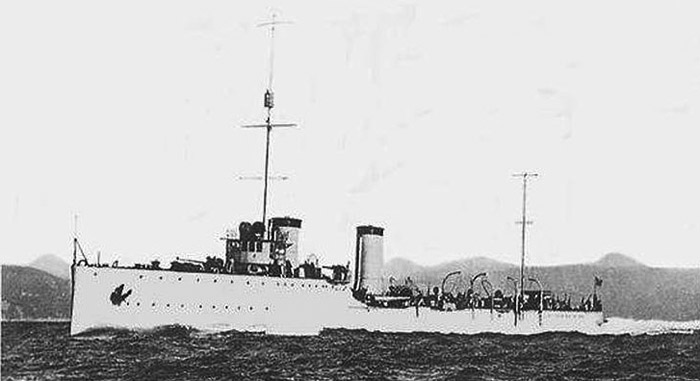
Carlo Alberto Racchia
Design of the class

The Austro-Hungarian Tátra class
Since the acquisition of HMS Swift by the RN (forced upo by Lord Fisher) alongside and the Tribal class destroyers, shipyards started to develop larger destroyers for oceanic use. Britain developed its first larger flotilla leaders, the Marksman class ordered in 1912 and in service from July 1915. They were larger, faster, had better range and better armament than anything else afloat and were patrtly motivated by the Russian’s Novik class built at the time in 1911 at the German Vulkan Yard in service by 1913. More of these were built with variations until the revolution of 1917. Britain also built for Chile the large Almirante Lynch class and for Argentina the La Plata class of for the Austro-Hungarian Navy the Tátra class. The latter especially became a concern for the Regia Marina which standard destroyers were much smaller (Pilo class and earlier).
The Italian Regia Marina made similar considerations when ordering the Poerio-class destroyers in 1912. Soon the program was extended to an improved variant, called the Mirabello class. After Italy entered the war in April May 1915, the four ships under construction for the Romanian Navy at Pattison, Naples, were confiscated, incorporated as the Aquila class, all armed with three 15 cm guns and classified as esploratori. Meanwhile, design on the new Mirabello class started in early 1914 and were rushed to completion in August as the war broke out, leading to lay down the keel of Carlo Mirabello by November 1914. Two more were laid down quickly in December and February 1915. Construction was sped up until launch between December 1915 and December 1916.
The Carlo Mirabello class were not the first Italian light scout cruisers. They were much smaller than the previous Esploratori (incrociatore) such as the Nino Bixio class or Quarto, and more in line with the smaller Poerio class. The latter were close to destroyer leaders in size (those of the Scott class in 1917 for example). They were from 5000 to 2000 tonnes. Thus, they were smaller, cheaper, and faster. The RN found them successful enough that they ordered another serie at the end of the war, the Leone class. Like the latter, they took part in both world wars (but for one).
Hull and general design
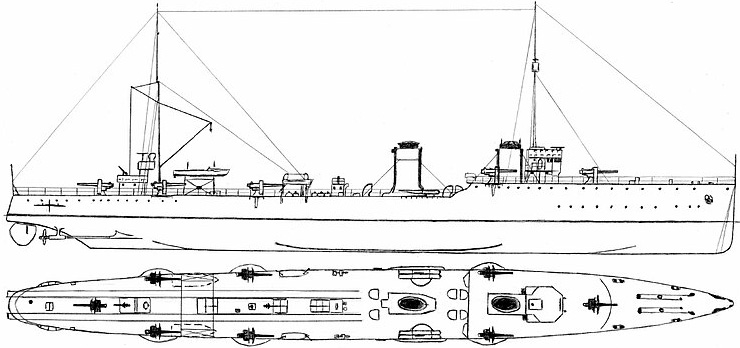
Drawing of the class, 2 views
The ships were designed as scout cruisers (esploratori) and looked like essentially as large destroyers with the same forecastle. They were much larger than the previous Poerio class, dosplacing 1,784 tonnes (1,756 long tons) standard, 2,040 tonnes (2,010 long tons) fully loaded, with an overall length of 103.75 meters (340 ft 5 in), 9.74 meters in beam (31 ft 11 in) and mean draft of 3.3 meters (10 ft 10 in). The hull was roomy with the forecastle located at 1/3 roughly of the lenght. She had a minimalistic, low structure forward with short wings and enclosed/open bridge above. She had two ovale funnels, one at the forecastle break, the other further aft, lower, two pole masts, the fore one being thicker and supporting a small spotting top, and there was a thinner compose aft mast, both of the same height and supporting wireless telegraphic cables.
The was a tiny quartedeck house aft close to the mast, because ot was framed by the two sets of mine rails. Another tiny structure amidship carried a night projector. The orthe was located on a platform seated close to the aft mast. There were also two telemeters, one on the bridge forward, the other on the lower platform aft close to the projector and mast.
The rest of the deck was bare, apart accesses hatches. She was focused on artillery first, torpedo second: She just had two banks close to the forecastle on either beam, but eight 102 mm guns, quite an improvement over the Poerio (only six). They were all shielded and apart two on the axis fore and aft, they were all sponsoned on the broadsides.
The crew comprised 8 officers and 161 enlisted men. The Mirabello class had four rescue boats under davits, the rest were mae wests in bins.
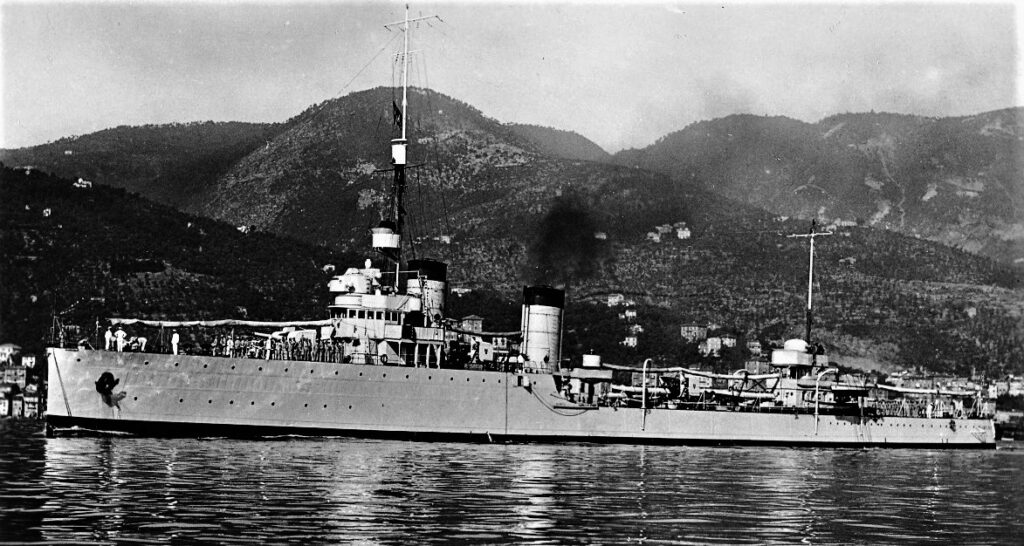
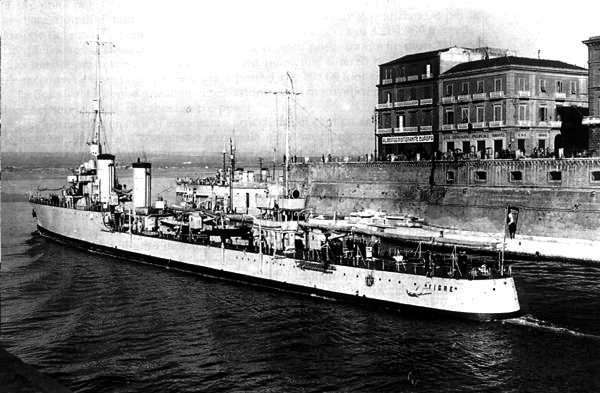
The strongly related, later Leone class (Pantera top, Tigre below). Note the similarities.
Powerplant
The Mirabellos were powered by two Parsons geared steam turbines, driving each a three bladed propeller shaft. Steam came from four Yarrow boilers. This was thus an all (British powerplant as the IOtalian Navy wanted the best powerplant available for these ships to achieve maximum output, 44,000 shaft horsepower (33,000 kW) in that case. This procured a top speed of 35 knots (65 km/h; 40 mph). This was far better than the Poerios, only capable of 30 knots. The ships also carried 385 tons of fuel oil for a range of 2,300 nautical miles (4,300 km; 2,600 mi) at 12 knots (22 km/h; 14 mph), far more appropriate as scouts even in the confines of the Mediterranean.
This was reduced to 500 nm at 32 knots and decreased significantly over the course of their service life. In 1940 this was down to just 27 knots and the naval staff wanted them decommissioned before they were pressed in service again, as escorts.
Armament
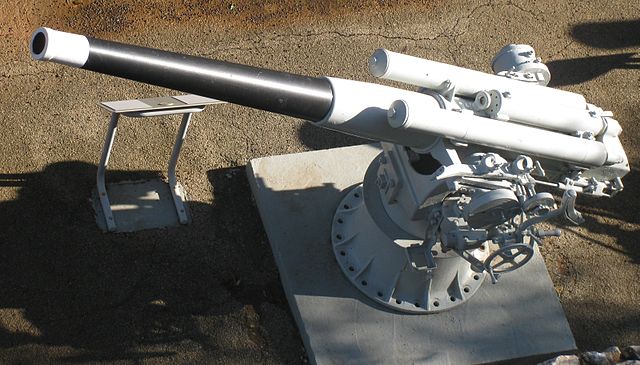
Their main battery comprised as said above eight Vickers-Terni Cannone da 102 mm (4 in)/35 S Modello 1914 guns. They were all in single mounts and protected by gun shields (likely with 8 mm or 0.3 in thick armour). One was placed in the axis at each end, foecastle and poop deck, the remaining guns positioned on the broadside amidships with sponsoned to allow the crew some leeway in extreme traverse.
Main
The Vickers Terni 102 mm (4-in)/35 weighted 1,220 kg (2,690 lb) for 3.73 m (12 ft 3 in) long, firing a 13.7–15 kg (30–33 lb) 102 x 649mm R HE shell. It used a Horizontal or Vertical sliding breech block. Elevation was -5° to +45° and rate of fire 7 rpm. Muzzle velocity was 755 m/s (2,480 ft/s) and effective range 9.4 km (31,000 ft) max 11.7 km (7.3 mi) at +45°.
Only Carlo Mirabello was completed to this configuration.
Racchia and Riboty went for a Cannone da 152 mm (6 in)/40 A (Ansaldo) Modello 1891 forward, the rest being the same. Carlo Mirabello received had one too by 1917, but this gun proved to be too heavy with a too low rate of fire. It was kept anyway. Armament evolved however in time (see later).
AA
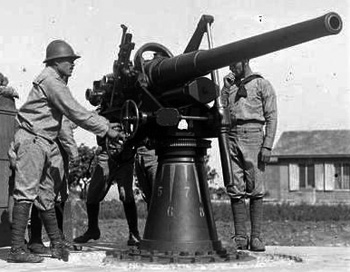 Anti-aircraft armament consisted of two pair Cannone da 76 mm (3 in)/40 Ansaldo Modello 1916 AA guns, both in single mounts. They were placed in the axis, one amidship, between the two side 4-in guns and the latter above the small structure aft.
Anti-aircraft armament consisted of two pair Cannone da 76 mm (3 in)/40 Ansaldo Modello 1916 AA guns, both in single mounts. They were placed in the axis, one amidship, between the two side 4-in guns and the latter above the small structure aft.
Specs: 510 kg (1,120 lb), pivot mounted, no shield, 3.13 m (10 ft 3 in) long, Barrel 3 m (9 ft 10 in), 40 caliber
Crew: 7. Fixed QF 76.2 x 420mm R shell 5.6–6.5 kg (12–14 lb) 76.2 millimeters (3.00 in)
Elevation -6° to +81°, 12-15 rpm, Mv 680 m/s (2,200 ft/s) range 5.8 km (19,000 ft) at +70°, 4.8 km (16,000 ft) ceiling
Torpedo Tubes
Their four 450-millimeter (17.7 in) torpedo tubes were mounted in two twin banks on each broadside. These were likely De Luca tubes, 193 caliber, firing an Italian made A110 or A115, 115 kgs (5.28 or 5.23 m) capable of 38 kts at 1000m for the first and between 30 kts at 3000m setting, 36 at 2000 and 41 at 1000m.
Mines
Augusto Riboty could carry 120 mines, her sisters 100. This was either due to longer tracks (albeit stopped by air intakes), or just smaller mine types. The latter was unknown.
If moored, Sautter-Harlé type with 220 lbs. (100 kg) charge and 330 foot (100 m) mooring cable.
If not, Bollo or Elia types. See more
Modifications
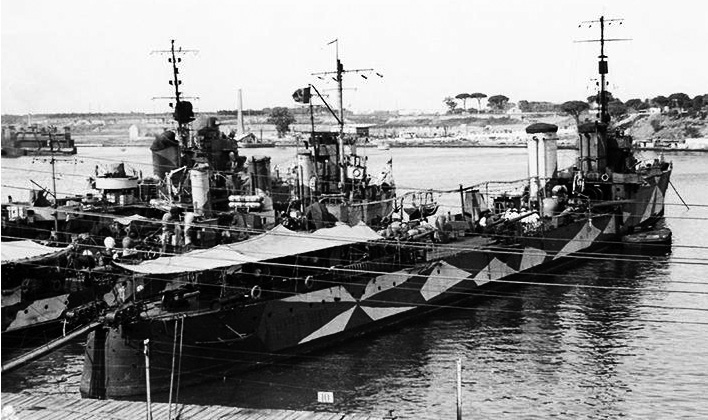
Aug. Riboty in 1942, camouflaged
Carlo Mirabello obtained two 6.5mm/80 machines guns, Carlo Alberto Racchia too. Augusto Riboty as well but carried 120 mines as said above.
In 1917, Carlo Mirabello also swapped its forward gun for a 152mm (6-in)/47 G.L/50 K.10.
In 1919 the two surviving were rearmed with eight Cannone da 102/45 S, Ansaldo, Modello 1917 guns. They were as on Mirabello. The 76 mm guns were replaced Cannone da 40 mm (1.6 in)/39 AA guns, with also single mounted and same places, in 1920–1922. The 102mm/35 T1914 was swapped back in place instead of the 6-in, too slow as stated above.
In 1920-1922, the eight 102mm/35 were replaced by 102mm/45 Schneider-Canet 1917 as said, and the 76mm (3-in)/40 were replaced by 40mm/39 Vickers-Terni 1917.
In 1925, Carlo Mirabello tested a seaplane temporarily. No catapult, just a crane for laying/recovery.
That was their appareance when WW2 broke out. During the war however, further modifications were made:
In 1942 Augusto Riboty saw the removal of two 102mm/45 and the two old MGs, anf gained one 40mm/39 Vickers-Terni 1917 AA and two Breda 8.80mm LMGs.
In 1943, Augusto Riboty lost also two 4-in guns and three 40mm/39, as well as her trpedo tibes and instead gained six 20mm/70 Oerlikon AA and DCTs as an escort during the co-belligerence.
⚙ specifications |
|
| Displacement | 1,784 t (1,756 long tons) normal, 2,040 t (2,010 long tons) deep load |
| Dimensions | 103.75 x 9.74 x 3.3 m (340 ft 5 in x 31 ft 11 in x 10 ft 10 in) |
| Propulsion | 2 shafts Parsons steam turbines, 4 Yarrow boilers, 35,000 shp (26,000 kW) |
| Speed | 35 knots (65 km/h; 40 mph) |
| Range | 2,300 nmi (4,300 km; 2,600 mi) at 12 knots (22 km/h; 14 mph) |
| Armament | 8× 102 mm, 2× 76 mm AA gunsn 2×2 450 mm TTs, 100-120 mines |
| Crew | 8 officers and 161 enlisted men |
Read More/Src
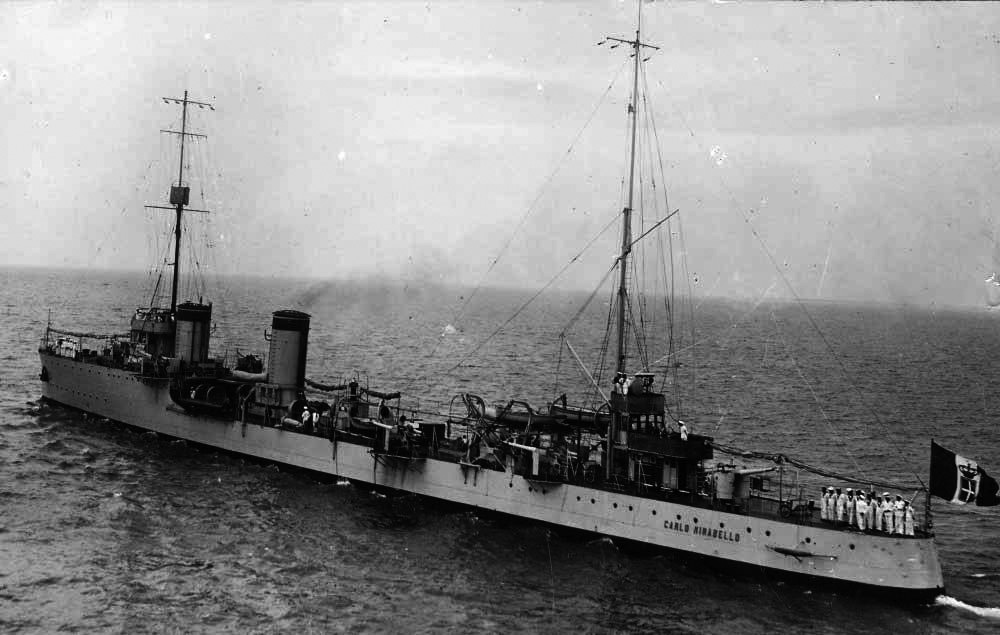
Carlo Mirabello postwar, src navyworld
Books
Brescia, Maurizio (2012). Mussolini’s Navy: A Reference Guide to the Regina Marina 1930–45. Annapolis, Maryland: Naval Institute Press.
Campbell, John (1985). Naval Weapons of World War Two. Annapolis, Maryland: Naval Institute Press.
Fraccaroli, Aldo (1970). Italian Warships of World War 1. London: Ian Allan.
Fraccaroli, Aldo (1968). Italian Warships of World War II. Shepperton, UK: Ian Allan.
Friedman, Norman (2011). Naval Weapons of World War One: Guns, Torpedoes, Mines and ASW Weapons of All Nations; An Illustrated Directory. Barnsley: Seaforth Publishing.
Gray, Randal (1985). Conway’s All The World’s Fighting Ships 1906–1921. London: Conway Maritime Press.
McMurtrie, Francis E., ed. (1937). Jane’s Fighting Ships 1937. London: Sampson Low.
Roberts, John (1980). “Italy”. In Chesneau, Roger (ed.). Conway’s All the World’s Fighting Ships 1922–1946. New York: Mayflower Books. pp. 280–317.
Rohwer, Jürgen (2005). Chronology of the War at Sea 1939–1945: The Naval History of World War Two (Third Revised ed.). Annapolis, Maryland: Naval Institute Press.
Whitley, M. J. (1988). Destroyers of World War 2: An International Encyclopedia. Annapolis, Maryland: Naval Institute Press.
Cernuschi, Enrico (2022). “Esploratori of the Regia Marina, 1906—1939”. In Jordan, John (ed.). Warship 2022. Oxford: Osprey Publishing.
Links
comandosupremo.com/evolution-of-italian-destroyers/
on navypedia.org/
naval-history.net/ ItalianNavy1914-1918.htm
en.wikipedia.org/
marina.difesa.it
uboat.net/l
subsim.com/
Model Kits
Only model found, one which the manufacturer was not mentions (german) and could have been scratch-built:
review of a 1:700 kit on modellmarine.de
 Carlo Mirabello
Carlo Mirabello
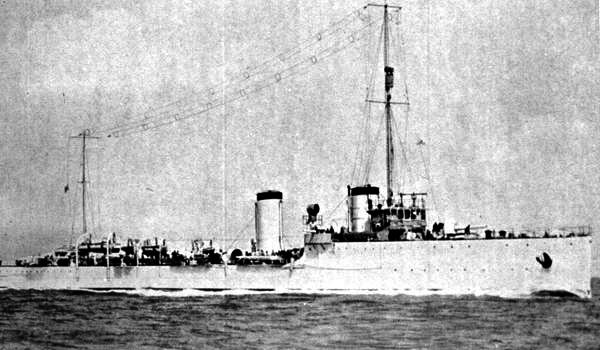
WWI Operations:
Mirabello once completed, participated in the operations Adriatic operations by 1915.
On 22 December 1916, 5 pm, she was sent for a mission in the Otranto Canal, near a recent clash between Italian-French and Austro-Hungarian units. She arrived too late.
On 24 December she supported with the destroyers Impavido and Ippolito Nievo, an action by MAS-3 and MAS-6, which, towed respectively by the coastal torpedo boats 36 PN and 54 AS, to attack the Austro-Hungarian ships in Durazzo harbour. But the action was cancelled 3 miles away as MAS 6 was badly damaged by hitting wreckage.
On the night of 14-15 May 1917, mirabello was cruising in the Otranto Canal between Durazzo and Capo Rodoni with the French destroyers Rivière, Bisson and Cimeterre, when they were ambushed by Austro-Hungarian units trying to destroy the armed trawlers patrolling the anti-submarine barrier of the Otranto Canal. As a diversionary action they attacked at the same time an Italian convoy heading for Albania. At 4.30 on 15 May, Mirabello and the French destroyers were redirected to the barrage, and arrived a 6AM in the morning, spotting smoke at their starboard bow, 6 miles away: These were the SMS Saida, Helgoland and Novara, which just sunk 14 trawlers. Mirabello headed southwest to attack, started firing at 7:10 AM from 8,000 meters. Mirabello was twice near-missiled by torpedoes fired bu the present Austro-Hungarian U-boats and dodged them before returning to formation. They could not approach and lost them but the Austrian ships were later met by other Italian and RN ships, were hit but returned to Pola.
On 10 March 1918 Mirabello and Riboty, supported the scouts Poerio and Rossarol, destroyers Giacinto Carini and Pilade Bronzetti and French destroyer Casque when covering the destroyer-towed MAS 99 and 100 (by Nievo and Mosto) for an attack on Porto Rosa, postponed due to bad weather, on 16 March again and 8 April after being spotted by an Italian aerial reconnaissance which discovered the harbour was empty.
At 18:10 PM on 12 May, she left Brindisi to support with Riboty another action by MAS 99 and 100 towed by Nievo and Bronzetti to Durres. This time they attacked, MAS 99 managed to hit during the night attack on the 13th the steamship Bregenz, which sank, not the other. However the fleet was in high alert and the fleet returned unscathed to Brindisi.
At 9:00 AM on 9 November, again from Brindisi, Mirabello and Racchia, took part in the occupation of Lissa.
In total she performed 65 missions, including laying mines.
Interwar:
In 1919 she was deployed to Kotor (Dalmatia) before by treaty the country became part of Yugoslavia. On 15 March 1924, she escorted Brindisi to Fiume to embark Vittorio Emanuele III, for the annexation ceremony of the city to Italy.
From 24 April to 30 October 1924, under captain Vladimiro Pini, the went from Venice to La Spezia over 11,000 miles, also stopping at Castellammare del Golfo, Algiers, Gibraltar, Lisbon, Corcubión, Brest, Antwerp, Flekkefjord, Oslo, Gothenburg, Karlskrona, Stockholm, Turku, Helsinki, Leningrad, Tallinn, Riga, Libau, Gdansk, Zoppot, Szczecin, Sassnitz, Copenhagen, Lübeck, Travemünde, Hamburg, Rotterdam, Cherbourg , Portugalete, Lisbon, Almería, passing Gibraltar Strait and entering rivers such as the Tagus, Neva, Scheldt or Rupel canal and passed the Skagerrak Strait, entered Oslo Fjord. In 1925 he won a shooting competition. Later she had a refit, gaining new 40 mm AA guns, new hydrophones and new depth charges racks.
She took part in Mediterranean exercizes, with port calls and between October 1936 and September 1938 took part in “neutrality patrols” around Spain. In 1938 she was redesignated a destroyer, her speed down to 27 knots and no telemeters, scheduled for decommission when WW2 broke out in September 1939.
WW2:
She was fully crewed and prepared, placed in a destroyer formation in Brindisi with Riboty. She was assigned to patrol the southern Adriatic and Ionian Sea, escorting convoys to Albania and Greece.
Then she transported “spec ops teams” for the planned landing in Corfu from 31 October 1940 with the cruiser Bari and Taranto, TBs Curtatone, Monzambano, Castelfidardo and Calatafimi, Confienza, Solferino, Prestinari, Cantore, Fabrizi, Medici, Stocco, and auxiliary cruisers RAMB III, Capitano Cecchi, Lago Tana and Lago Zuai, plus four MAS of the XIII Flotilla, three Sesia class tankers, but it was canceled and instead they landed troops in Vlora. On 20 May Mirabello left Brindisi for Patras with the auxiliary cruiser Brindisi, merchants Annarella and Laura C., tankers Strombo and Anna C. and at 5:40 AM, May 21, and explosion was spotted 5-8 miles away off Cape Dukato, Ionian archipelago, the gunboat Matteucci which hit a mine. Mirabello raced towards her and prepared to lower a lifeboat when she hit another mines (A field laid by the British minelayer HMS Abdiel) and the deflagration severed her bow. The bulkheads resisted and she was adrift but the flooding would not be stopped and she was evacuated and scuttled by the crew at 11.45 AM, after six hours, 2 miles south of Cape Dukato. 63 men were rescued by Brindisi the rest swam ashore or were pickuped up by other vessels but 44 were missing.
 Carlo Alberto Racchia
Carlo Alberto Racchia

WW1 operations
Racchia was based in Brindisi in May 1915, she started patrols in the Adriatic, and her first mission started in the night of 14-15 May 1917 in the Otranto Canal and she took part in the same battle as her sister with three Austro-Hungarian destroyers, on 15 May. She found with the scouts Aquila and Marsala, British light cruiser Liverpool and destroyers Insidioso, Impavido and Indomito to help the light cruiser HMS Dartmouth and two other RN destroyers engaged in between and a 7:45 AM spotted and engaged the Austro-Hungarian destroyers SMS Csepel and Balaton, starting fire at 8:10, while Aquila attacked the two opposing ships. Then Racchia, Marsala, Liverpool and Dartmouth headed for Cattaro to cut their retreat. The battle ended with not ship sunk and few hits.
On 16 July with Riboty she took part in an attack on Durres with 18 planes. On 4-5 October 1917 she sailed with Aquila on a combined sea-air attack against Cattaro.
On 2 October 1918 she escorted the battleship Dante Alighieri, scours Rossarol, Pepe and Poerio, destroyers Nievo and Schiaffino in support for a sortie from Cattaro to interfere on the Durazzo shelling. November 9th, 1918, she participated with Mirabello in the occupation of Lissa.
Interwar:
On 20 March 1920 she sailed to Constantinople, patrolled the Bosphorus and Black Sea and by 19 July she went to Odessa, escorting a convoy for the merchants Calvi, Melpomene and Thalia with 14,000 former Russian POWs captured by Italian troops after the Austro-Hungarian surrender. They were returned to help the Bolsheviks under the initiative of the Italian Socialist Party. On 21 July, 11:00 AM however, Racchia hit a mine while 9 miles SW of Capo Fontana, 19 miles from Odessa. She had 10 dead and 9 injured and was abandoned 40 minutes after and sank bow-first. She was stricken in 1922.
 Augusto Riboty
Augusto Riboty

WW1 Operations
From Brindisi in 1916, Riboty was poised for patrols, attack support, escorts and interceptions, or minelaying operations in the Adriatic. By 16 July 1917 she sailed with Carlo Alberto Racchia to provide remote support for the air attack on Durazzo from Brindisi and Vlora.
On 10 March 1918 she supported an operation under command of Rear Admiral Biscaretti on board, with Mirabello, Poerio and Rossarol, Giacinto Carini and Pilade Bronzetti, French destroyer Casque with MAS 99 and 100 on Porto Rosa, postponed due to bad weather twice and cancelled after an air reconnaissance.
On 12 May from Brindisi with Mirabello she took part in another attack on Durazzo, moderately successful.
On November 4, from Brindisi she sailed for Lagosta and landed a party on the island. When V-Day came, she comleted 52 missions.
Interwar:
From 27 December 1918 to 12 January 1919 she was in Split to assist Italian citizens, protect interests and watch over development of the situation in Dalmatia, while ethnic hatred saw growing incidents. Admiral Enrico Millo asked her crew to provide food and assistance to the population for pro-Italian propaganda reasons. On 12 January 1919 she left, replaced by the torpedo boat Puglia. The consul Marcello Roddolo was now hosted on Riboty and prepared the Italian troops to the possible Serbian counter attack to the occupation. Riboty came home later;
In 1923 she was commanded by captain Giuseppe Cantù and until February 1925, by Umberto Bucci. In 1938 she was reclassed as destroyer scheduled for decommission when the war broke out.
Second World War:
She was based in Brindisi with Mirabello by June 1940. She operated in the southern Adriatic and Ionian Seas for operations in Albania and Greece, and the Strait of Sicily. On 27 September 1940, she collided in Brindisi with the destroyer Zeno. On 5 October she left Durres escorting steamships Olimpia and Carnia when they were ambushed by sub HMS Triton, which torpedoed Olimpia (she survived).
She was to take part in the landing in Corfu, later cancelled. By 18 December she was with Raimondo Montecuccoli and Eugenio di Savoia, destroyers Antonio Pigafetta, Nicoloso da Recco and Emanuele Pessagno to shell Greek positions near Corfu. On 1 March 1941 did th same with the torpedo boat Andromeda. During convoy escorts she was confronted with British submarines several times, on 18 July 1941 (Adriatic), 5 August (Zakynthos) and 25 October 1941 (Patras). In 1942 as the sold surviing ship she was modernized as escort and further by 1943. By 5 February 1943 she escorted the tanker Utilitas on Taranto-Palermo when, attacked by HMS Turbulent, which sank Utilitas off Capo Zafferano, Palermo.
At 11:20 AM, 15 February she left Palermo, under Dpt. ltnt. Nicola Ferrone, escorting the merchants Alcamo, Frosinone and Chieti to Bizerte twith the TBs Sirio and Monsone, corvettes Antilope and Gabbiano but had to divert to Trapani due to engine failures. On 3 April while underway in the Gulf of Taranto, she dodged a torpedo attack by RN sub. She had to assist the tanker Regina, hit.
On 12 September 1943, armistice day, she sailed from Taranto with the submarines Atropo, Jalea and Fratelli Bandiera to Malta on the 13th. She arrived at St. Paul’s Bay and then Marsa Scirocco. On 6 October 1943 she left Malta with TBs Orione and Ariete, 6 submarines and 2 vessels to return to Italy for the Co-Belligerent navy. Until 1945 she escorted US convoys and supplied the battleships Italia and Vittorio Veneto interned at the Bitter Lakes. When the war ended she had completed a grand total of 365 war missions over 70,350 miles of navigation from 1940. She was celebrated during her decommissioning ceremonies as the “most active Italian destroyer of the Second World War” her flag being awarded the Bronze Medal for Military Valor. The peace treaty attributed her to the Soviet Union, but rejected by the latter as too old, she became a pontoon in Taranto, stricken by February 1950, sold and BU in 1951.

 Latest Facebook Entry -
Latest Facebook Entry -  X(Tweeter) Naval Encyclopedia's deck archive
X(Tweeter) Naval Encyclopedia's deck archive Instagram (@navalencyc)
Instagram (@navalencyc)





 Austrian Navy
Austrian Navy French Navy
French Navy Royal Navy
Royal Navy Armada Espanola
Armada Espanola K.u.K. Kriegsmarine
K.u.K. Kriegsmarine Dansk Marine
Dansk Marine Nautiko Hellenon
Nautiko Hellenon Koninklije Marine 1870
Koninklije Marine 1870 Marinha do Brasil
Marinha do Brasil Osmanlı Donanması
Osmanlı Donanması Marina Do Peru
Marina Do Peru Marinha do Portugal
Marinha do Portugal Regia Marina 1870
Regia Marina 1870 Nihhon Kaigun 1870
Nihhon Kaigun 1870 Preußische Marine 1870
Preußische Marine 1870 Russkiy Flot 1870
Russkiy Flot 1870 Svenska marinen
Svenska marinen Søværnet
Søværnet Union Navy
Union Navy Confederate Navy
Confederate Navy Armada de Argentina
Armada de Argentina Imperial Chinese Navy
Imperial Chinese Navy Marinha do Portugal
Marinha do Portugal Mexico
Mexico Kaiserliche Marine
Kaiserliche Marine 1898 US Navy
1898 US Navy Russkiy Flot
Russkiy Flot French Naval Aviation
French Naval Aviation Russian Naval Aviation
Russian Naval Aviation Sovietskiy Flot
Sovietskiy Flot Royal Canadian Navy
Royal Canadian Navy Royal Australian Navy
Royal Australian Navy RNZN Fleet
RNZN Fleet Chinese Navy 1937
Chinese Navy 1937 Kriegsmarine
Kriegsmarine Chilean Navy
Chilean Navy Danish Navy
Danish Navy Finnish Navy
Finnish Navy Hellenic Navy
Hellenic Navy Polish Navy
Polish Navy Romanian Navy
Romanian Navy Turkish Navy
Turkish Navy Royal Yugoslav Navy
Royal Yugoslav Navy Royal Thai Navy
Royal Thai Navy Minor Navies
Minor Navies Albania
Albania Austria
Austria Belgium
Belgium Columbia
Columbia Costa Rica
Costa Rica Cuba
Cuba Czechoslovakia
Czechoslovakia Dominican Republic
Dominican Republic Haiti
Haiti Hungary
Hungary Honduras
Honduras Estonia
Estonia Iceland
Iceland Eire
Eire Equador
Equador Iran
Iran Iraq
Iraq Latvia
Latvia Liberia
Liberia Lithuania
Lithuania Mandchukuo
Mandchukuo Morocco
Morocco Nicaragua
Nicaragua Persia
Persia San Salvador
San Salvador Sarawak
Sarawak Uruguay
Uruguay Venezuela
Venezuela Zanzibar
Zanzibar Warsaw Pact Navies
Warsaw Pact Navies Bulgaria
Bulgaria Hungary
Hungary

 Bundesmarine
Bundesmarine Dutch Navy
Dutch Navy Hellenic Navy
Hellenic Navy Marina Militare
Marina Militare Taiwanese Navy
Taiwanese Navy Chinese Navy
Chinese Navy Indian Navy
Indian Navy Indonesian Navy
Indonesian Navy JMSDF
JMSDF North Korean Navy
North Korean Navy Philippines Navy
Philippines Navy ROKN
ROKN IDF Navy
IDF Navy Royal New Zealand Navy
Royal New Zealand Navy Egyptian Navy
Egyptian Navy South African Navy
South African Navy

































 RN
RN
 Marine Nationale
Marine Nationale
 Soviet Navy
Soviet Navy
 dbodesign
dbodesign